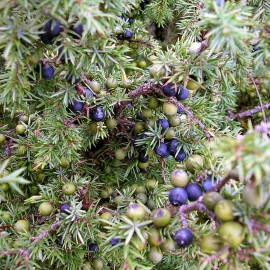



Organic Common Juniper Seeds (Juniperus Communis)
1.14 €
The Common Juniper has the largest range of any woody plant, throughout the cool temperate Northern Hemisphere ranging from the Arctic south through mountainous areas to around 30°N latitude in North America, Europe and Asia.
-
Organic Common Juniper (Juniperus Communis)
The Common Juniper has the largest range of any woody plant, throughout the cool temperate Northern Hemisphere ranging from the Arctic south through mountainous areas to around 30°N latitude in North America, Europe and Asia.
It is an evergreen shrub growing up to 9m (29ft) by 4m (13ft) at a slow rate. In good growing conditions, it can grow up to 28 cm per year. Flowering and seed production begins when the plants are 7-10 years old. The individual flowers are either male or female, but only one sex is to be found on any one plant so both male and female plants must be grown if seed is required) and are pollinated by wind. The plant is not self-fertile.
It is in flower from May to June, and most seeds ripen in the Autumn although they can often be seen throughout the year. They are too bitter to eat raw and are usually sold dried and used to flavour meats, sauces, and stuffing's. They are generally crushed before use to release their flavour. They are also used to flavour certain beers
How to Grow
Seeds of the Juniper are widely known to be difficult to germinate and grow. The seed's dormancy is deep and can be difficult to break. It is necessary for the seeds to undergo at least several cycles of warm and cold pre-treatments to ensure germination. In general, the seeds will fail to germinate unless treated in this way.
Simply sowing untreated seeds in compost at room temperature will not break down the dormancy and germination will be disappointing. To begin first soak the seeds for 24 hours in warm water (not boiling) and allow it to cool. Drain off as much water as possible.
Prepare a free draining substrate into which the seeds are to be mixed, this can be a 50/50 mixture of compost and sharp sand, or perlite, vermiculite. The chosen substrate needs to be moist (but not wet), if you can squeeze water out of it with your hand it is too wet and your seeds may drown and die.
Mix the seeds into the substrate, making sure that their is enough volume of material to keep the seeds separated. Place the seed mixture into a clear plastic bag (freezer bags, especially zip-lock bags are very useful for this -provided a little gap is left in the seal for air exchange) If it is not a zip-lock type bag it needs to be loosely tied. Write the date on the bag so that you know when the pre-treatment was started.
The seeds first require a period of warm pre-treatment and need to be kept in temperatures of 20 Celsius (68F) for a period of at least 12 weeks - it is not critical if it lasts a week or two longer than this. During this time make sure that the pre-treatment medium does not dry out at any stage or it will be ineffective!
Next the seeds require a cold period, this is easily achieved by placing the bag in the fridge (4 Celsius or 39F) for at least 12 weeks, again if it is for a little longer it does not matter. It is possible for the seeds to germinate in the bag at these temperatures when they are ready to do so, if they do, just remove them from the bag and carefully plant them up. The seeds are now ready to be sown.
Fill your chosen container with a good quality general potting compost. Suitable containers could be plant pots, seed trays or even improvised containers with drainage holes. Firm the compost gently and sow the seeds on the surface. Cover the seeds with a couple of millimeters of vermiculite or a fine layer of sieved compost. Follow with a gentle watering and keep them at room temperature, out of direct sunshine. Germination should begin a few weeks from sowing.
The seedlings are small and usually trouble free and usually grow to a height of between 2 and 5 cm in the first growing season depending on the sowing date and cultural techniques. More seeds may germinate in subsequent seasons, possibly for several years so please be patient.
Keep developing seedlings out of full sun, keep them well watered and free of competing weeds. Growth will accelerate in the second and subsequent years and the developing young trees should be re-potted as necessary preferably during the dormant season. After perhaps 3 years they are ready to be planted in their permanent position.
